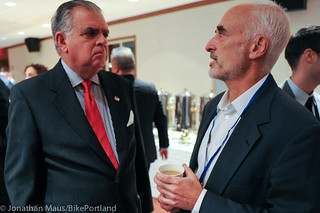
secrets from US DOT Secretary Ray LaHood.
(Photos © J. Maus/BikePortland.org)
As you might expect at a conference about innovative street designs and city planning, the City of Portland has sent a team to participate. Here at the NACTO Designing Cities conference, I’ve bumped into several Bureau of Transportation staffers. I tracked them down during a break for lunch and asked each of them why they’re here…
made possible by:
- Planet Bike
- Lancaster Engineering
- Readers like you!
Roger Geller has worked on bicycling in Portland for decades. He’s one of the national leaders in implementing innovative designs and policies. Even so, he knows learning from peers is invaluable. Roger said he’s here to “get the straight dope” from other bike planners about how they’re addressing road blocks and barriers when it comes to bike projects and policies. In an informal chat with US DOT Secretary Ray LaHood, Geller asked him why there aren’t more champions for cycling on Capitol Hill. (His answer: “People haven’t pushed them enough on it.”)
Paul Smith attended a panel session this morning titled: “Financing City Transportation Infrastructure.” Along with wanting to learn more about how cities are designing narrow streets, Paul said, “There’s lots of good discussion here in terms of things we haven’t thought of yet in terms of project financing.”
Peter Koonce is here to share the innovative traffic signal work he’s doing. “The MUTCD [Manual on Uniform Traffic Control Devices, a federal guidebook of signage and signal standards] doesn’t recognize all the bike signal work we are doing, but we’re using them and they’re working great.” Peter is known around the country for his signal work and is on the panel of editors for the newly released NACTO Urban Street Design Guide.
Tom Miller said he came because the agenda for this conference is the best one he’s seen in his eight years in working for the City. “It’s like, aahh, somebody understands me.” He was speaking about how the conference is focused like a laser on teaching (and re-training) city officials on how to implement innovative transportation projects. “NACTO is where America’s cities are generating the best ideas,” he said, “and generating the best outcomes on the ground.” Tom’s top priority while at the conference is to learn more about funding and financing of projects (which, I learned today, are two different things). “Portland needs to reinvent itself when it comes to funding.” As for which city he sees as a model for Portland, Miller said he’s taking more of a “cherry-picking” approach. “I’ll grab good ideas when I see them.”
—
Other locals that are here at the conference include noted economist Joe Cortright (here to speak about his “Green Dividend” research) and Vancouver, Washington resident Todd Boulanger (representing BikeStation).
——
— This is part of my ongoing New York City coverage. I’m here for a week to cover the NACTO Designing Cities conference and the city’s bike culture in general. This special reporting trip was made possible by Planet Bike, Lancaster Engineering, and by readers like you. Thank you! You can find all my coverage from this trip here.


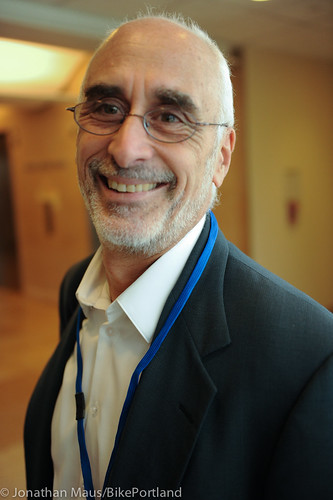
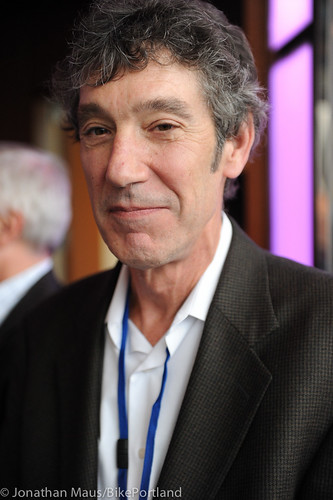
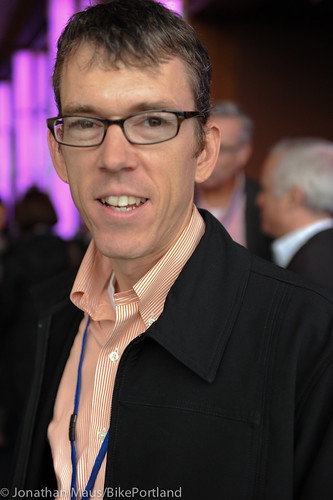
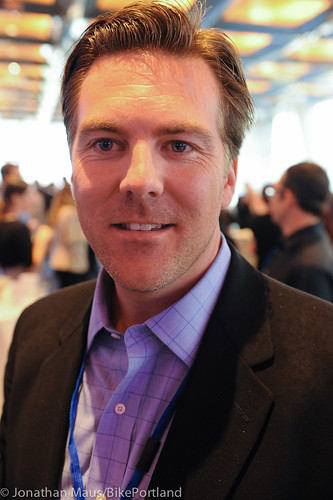
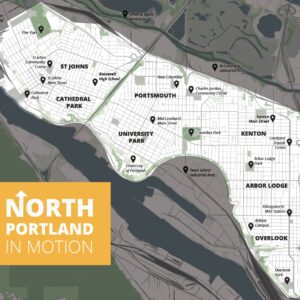



Thanks for reading.
BikePortland has served this community with independent community journalism since 2005. We rely on subscriptions from readers like you to survive. Your financial support is vital in keeping this valuable resource alive and well.
Please subscribe today to strengthen and expand our work.
“Along with wanting to learn more about how cities are designing narrow streets”
Very good to hear!
When I asked City officials about how to narrow my street a few years ago they drew a blank. When I pointed out that Portland is known for it’s Skinny Streets Ordinance they didn’t know what I was talking about and asked for a copy.
http://www.oregon.gov/LCD/docs/publications/neighstreet.pdf?ga=t
from p. 10 of this document:
“Safe and Livable. There is growing appreciation
for the relationship between street
width, vehicle speed, the number of crashes,
and resulting fatalities. Deaths and injuries
to pedestrians increase significantly as the
speed of motor vehicles goes up. In 1999,
planner Peter Swift studied approximately
20,000 police accident reports in Longmont,
Colorado to determine which of 13 physical
characteristics at each accident location (e.g.,
width, curvature, sidewalk type, etc.) accounts
for the crash. The results are not
entirely surprising: the highest correlation
was between collisions and the width of the
street. A typical 36-foot wide residential
street has 1.21 collisions/mile/year as opposed
to 0.32 for a 24 foot wide street. The
safest streets were narrow, slow, 24-foot
wide streets.”
I’d love to hear more about Paul Smith’s session about financing infrastructure.
I second that. If we’re hoping for more separated bikeways in the future, we’re going to need an expanded revenue stream and financing plans. If anyone’s got this figured out, we’d love to hear about it!
I’m curious: Are conference attendees primarily from big cities? Or are there folks from smaller cities representing their local DOTs?
It would help me to encourage transpo folks in my small city (pop. 26,000) if there were attendees from similar sized small cities who feel they have something to learn from the NACTO conference that they can use back home.
When ODOT official Lucy Moore told me studded tires cause $500,000 in damage to Oregon’s roads every year, that seemed like a good place to find some money. It’s time to ban studded tires. Only 16% of Oregonians use studded tires, it’s time they joined the rest of us and use our limited transportation money more wisely. Please contact your legislator and tell them you want this issue resolved and to stop giving into special interest like Les Schwab.